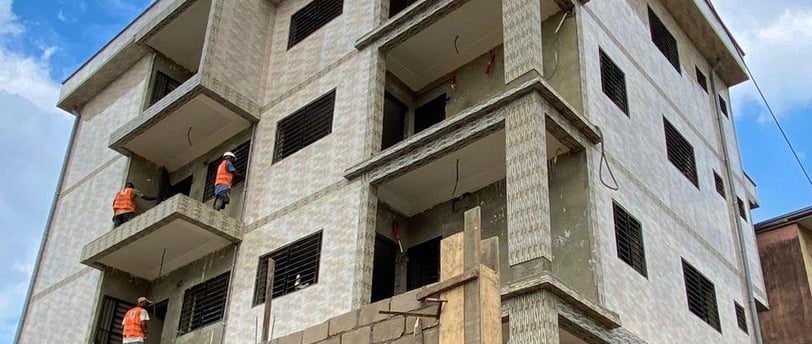Top 7 Finishing Mistakes to Avoid in Building Projects


Introduction to Finishing Mistakes
Finishing in building projects is a critical phase that encompasses the final stages where the detailed visual and functional elements are added to a structure. This can include everything from flooring selections and paint colors to installing cabinetry and fixtures. The finishing touches not only enhance the aesthetic appeal but also influence the overall functionality and durability of the structure. A well-executed finishing phase is essential for producing a high-quality, visually pleasing result that meets the client's expectations.
Despite the significant emphasis on foundational and structural aspects during construction, it is often the finishing details that truly define the success of a building project. Small mistakes during this phase can lead to consequential impacts, manifesting in both financial and aesthetic repercussions. For instance, poorly applied paint can chip over time, requiring costly touch-ups, while mismatched flooring can disrupt the visual flow of a space. Each of these mistakes not only incurs additional expenses for repairs but can also lead to dissatisfaction from clients, undermining trust and reputational integrity for builders.
Recognizing the importance of this stage can significantly influence project outcomes. Ultimately, the finishing phase is where vision meets reality, and meticulous attention to detail is paramount. As we delve deeper into the common finishing mistakes that occur during building projects, it will become evident how even minor oversights can derail a project’s success. Understanding these pitfalls will aid builders and contractors in navigating this crucial phase more effectively, ensuring that the final result aligns with both industry standards and client expectations.
Mistake #1: Poor Paint Choices
Choosing the right paint for building projects is critical, as poor paint selections can significantly undermine the overall quality and aesthetic appeal of the development. One core aspect of this mistake involves selecting a paint type that does not align with the intended use of the surface. For instance, exterior paints must be weather resistant and durable enough to withstand outdoor conditions, whereas interior paints should offer excellent coverage and ease of maintenance. If the wrong type of paint is applied, not only can it lead to premature peeling or fading, but it may also necessitate costly touch-ups or complete reapplication.
Color choice is another crucial element that can affect the project's outcome. Light and shadow can drastically alter the perception of color, meaning that a shade that appears appealing in a store may not produce the desired effect in the intended environment. Thus, it is vital to test samples in the actual space and under various lighting conditions, whether natural or artificial. This practice helps homeowners and builders visualize how the color will look throughout different times of the day and in various scenarios.
Compatibility with existing materials should also be taken into account. Different surfaces require specific preparation or primers, and painting over incompatible materials can lead to adhesion issues. By ensuring that the selected paint interacts well with the substrates, the longevity of the finish is upheld. For these reasons, it is advisable to consult with painting professionals or conduct thorough research to avoid poor paint choices that could compromise the integrity and visual appeal of a building project. Ultimately, investing the time to select suitable paint types and colors will enhance the outcome of any construction endeavor.
Mistake #2: Rushed Installations
In construction projects, the hastiness often exhibited during the installation phase can have lasting repercussions. Rushed installations stem from a variety of pressures such as tight deadlines, budget constraints, or the desire to expedite the project timeline. However, the ramifications of accelerating this crucial phase can be detrimental, resulting in compromised quality and safety. Proper installations of various components, including windows, fittings, and trim, demand meticulous attention to detail. Skipping steps, utilizing inferior practices, or omitting checks for alignment and adherence can lead to significant issues down the line.
For example, improperly installed windows may not only create aesthetic issues but can also lead to energy inefficiencies and water damage. Similarly, fitting cabinets or trim haphazardly can affect their longevity and stability, ultimately resulting in costly repairs or replacements. When craftsmanship is sacrificed for speed, the ramifications aren't simply cosmetic; they extend into functional territory, potentially jeopardizing safety and overall performance.
Moreover, hasty installations can contribute to structural inadequacies. Elements that are not adequately secured or positioned may shift over time, leading to further complications. This can necessitate expensive remedial work to rectify deficiencies caused by poor workmanship. It is critical to recognize that the installation process is foundational; any errors during this stage can reverberate throughout the entire project lifecycle, far outlasting the original rush to complete the task.
Thus, it is imperative to allocate adequate time for each installation. Each component should be set to precise specifications to ensure long-lasting performance and satisfaction with the finished project. Rushing may seem expedient in the short-term, yet it invariably leads to broader challenges, time consumption, and potential hazards that owners and contractors alike must ultimately confront.
Mistake #3: Ignoring Details
Attention to detail is a pivotal aspect of the finishing phase in building projects. It is during this stage that the aesthetic appeal and functionality of the final product are determined. Overlooking seemingly minor details can have significant repercussions, creating an impression of unprofessionalism or incompleteness. Common issues such as uneven lines, misaligned fixtures, and improper caulking can detract from the overall quality of a project, leaving clients dissatisfied.
One prevalent oversight occurs with uneven lines in paintwork or trim installations. A straight edge is vital for achieving clean lines; deviations can render the finish unsightly. Professional painters and builders understand that taking the time to measure and mark appropriately can make all the difference. Similarly, fixtures such as cabinets, door handles, or lighting must be meticulously aligned. Misalignment can disrupt the harmonious flow of design, which may also lead to functionality issues, especially in kitchens and bathrooms.
Proper caulking and sealing play an integral role in the finishing stage as well. Poorly executed caulking can lead to water damage, moisture intrusion, and mold growth, compromising the integrity of the structure. Careful application of caulk not only offers a seamless visual finish but also serves a functional purpose by preventing gaps that allow air or moisture leakage. Builders and contractors must prioritize these details, as addressing them during the finishing phase can mitigate significant issues down the line.
In essence, ignoring details in building projects may seem trivial, but it is precisely these elements that elevate a project from mediocre to exceptional. Invest time and attention in the finishing touches to ensure a polished, professional outcome that meets the expectations of any discerning client.
Mistake #4: Skipping Proper Cleanup
Proper cleanup after finishing work in building projects is an essential aspect that should never be overlooked. Neglecting this crucial step can lead to a range of aesthetic flaws and safety hazards that may compromise the overall quality of the project. A well-executed cleanup process not only enhances the visual appeal of the work but also ensures a safe and healthy environment for future occupants or users.
One of the primary elements of proper cleanup involves the removal of debris and waste materials generated during construction. Accumulated debris can create tripping hazards, reduce accessibility, and negatively impact the overall experience of the space once completed. Furthermore, paint spills left unmanaged can cause unsightly marks on flooring, walls, or fixtures, leading to additional work and expenses during touch-up phases.
In addition to physical debris, dust is another significant concern. Construction projects invariably generate dust, which can settle onto surfaces and negatively affect the appearance of finishes. Dust particles can also become airborne, posing health risks to those working in or visiting the space. A thorough cleaning protocol should include dusting all surfaces, vacuuming floors, and wiping down windows and fixtures to ensure that the space is pristine upon completion.
Establishing a robust cleaning routine should begin before the final inspection. This may involve creating a comprehensive checklist that addresses all areas requiring attention, such as removing construction materials, disposing of waste responsibly, and ensuring clean, clear surfaces. By prioritizing effective cleanup, project teams can not only improve the final appearance of their work but also create a safer and more inviting atmosphere for all who enter the completed space. Ultimately, taking the time to properly clean up following finishing tasks can greatly enhance the satisfaction of clients and occupants alike.
Mistake #5: Overlooking Lighting Considerations
Lighting plays a pivotal role in the perception and functionality of any finished building project. The impact of lighting cannot be overstated; it influences how colors appear, the visibility of materials, and the overall ambiance of a space. Different types of lighting—natural and artificial—can significantly alter the way finished interiors and exteriors are experienced. For example, a paint color that looks vibrant under daylight may appear dull under fluorescent or incandescent bulbs, which can ultimately affect the aesthetic quality of a space.
Moreover, the choice of lighting can enhance or detract from the characteristics of various materials used in the project. Textures that are highlighted by well-placed lighting can create a welcoming atmosphere, while poor lighting choices may obscure those very details. This necessity highlights the importance of incorporating lighting considerations throughout the design process, rather than treating it as an afterthought. When planning a building project, one should consider how the natural light will change throughout the day and how artificial light will complement those variations.
To mitigate the chance of overlooking these important factors, it is advisable to conduct mock-ups that incorporate different lighting scenarios prior to final installations. These tests can aid in making informed decisions about light fixtures, positioning, and types of bulbs that will best suit the intended atmosphere and aesthetic. Allowing for flexibility in the lighting design can further enhance the adaptability of the space. By carefully evaluating lighting conditions and planning accordingly, one can not only enhance the visual appeal of a project but also ensure its functionality aligns with users' needs.
Mistake #6: Failing to Consult Professionals When Needed
One of the most prevalent mistakes in construction and renovation projects is the reluctance to seek assistance from professionals when faced with complex finishing tasks. In an effort to save costs, some individuals opt to conduct these intricate tasks themselves, often overlooking the potential repercussions of such decisions. While DIY efforts can be rewarding, they may not always lead to the desired outcome, particularly in areas such as painting, flooring, or cabinetry installations, where precision and expertise are paramount.
Hiring professionals for these specialized tasks offers several advantages that can ultimately save both time and money. First and foremost, experts bring a wealth of knowledge and experience, which can significantly enhance the quality of the work performed. This expertise ensures that the final results meet industry standards and align with the expectations of the homeowner. Professionals are well-versed in the latest techniques, tools, and materials, allowing them to navigate challenges that might otherwise result in costly errors. For instance, improper preparation and application in painting or flooring may lead to premature wear, requiring a redo sooner than anticipated.
Additionally, professional contractors often have access to resources and materials at reduced rates, which can offset a portion of the costs associated with hiring them. Many homeowners may not be aware of the advanced solutions available; expert guidance can help realize the best possible options within budgetary constraints. It is essential for individuals to assess their own skills realistically and recognize where their limitations lie. In cases where tasks become overwhelming or complex, consulting professionals can be a pragmatic decision that enhances the overall quality and outcome of the project.
Conclusion
In any building project, the finishing phase is crucial as it determines the overall aesthetic appeal and functionality of the completed structure. Throughout this blog, we have identified several common mistakes to avoid during this integral stage. These errors may seem minor initially, but they can lead to significant repercussions, including increased costs, delayed timelines, and suboptimal results. Understanding the importance of the finishing phase ensures that every detail is meticulously attended to, ultimately creating a space that meets both design standards and practical requirements.
Being mindful of these finishing mistakes is essential for all who engage in construction, whether they are seasoned professionals or DIY enthusiasts. Key takeaways from our discussion include the necessity for proper planning, the significance of quality materials, and the value of expert craftsmanship. Each decision made during this phase contributes to the final outcome, and overlooking seemingly trivial aspects can result in dissatisfaction with the project upon completion.
To achieve a successful finish, it is vital to remain vigilant and proactive. This means conducting thorough inspections throughout the process to ensure that quality is maintained and that the work aligns with the initial vision. Encouraging communication between contractors, designers, and clients is paramount to address any potential issues prior to the completion of the project.
We invite our readers to share their experiences and insights related to the finishing phase of their building projects. Your tips and anecdotes can serve as valuable resources for others seeking to elevate their own projects and avoid similar pitfalls. A collaborative approach to learning can help foster even greater success in future endeavors, leading to beautifully finished spaces that are both functional and aesthetically pleasing.


